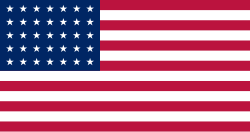
The United States Colored Troops (USCT) were regiments in the United States Army composed primarily of African-American (colored) soldiers, although members of other minority groups also served with the units. They were first recruited during the American Civil War, and by the end of that war in April 1865, the 175 USCT regiments constituted about one-tenth of the manpower of the Union Army. About 20% of USCT soldiers died, a rate about 35% higher than that for white Union troops. Despite heavy casualties, many fought with distinction, with 15 USCT receiving the Medal of Honor and numerous other honors.

The 28th Regiment United States Colored Troops, also called the 28th Regiment Indiana Infantry (Colored),1 was an African American combat unit from the state of Indiana that fought in the American Civil War.
The 1st Regiment Alabama Siege Artillery was an artillery regiment recruited from African-Americans that served in the Union Army during the American Civil War. The regiment was renamed the 6th US Colored Heavy Artillery. Under the leadership of Major Lionel Booth, the regiment fought at the Battle of Fort Pillow on April 12, 1864. The regiment then became the 7th US Colored Heavy Artillery, and later the 11th United States Colored Infantry.
The 2nd Alabama Volunteer Infantry Regiment was an infantry regiment that served in the Union Army between November 20, 1863, and June 25, 1864, during the American Civil War.
The 106th United States Colored Infantry Regiment was an infantry regiment of the United States Colored Troops, formed during the American Civil War. It was organized as the 4th Alabama Volunteer Infantry Regiment in late March 1864, and redesignated as the 106th United States Colored Infantry in May. The regiment spent its service on garrison duty at Pulaski, Tennessee, guarding railroads. It was consolidated into the 40th United States Colored Infantry Regiment in November 1865.
38th Regiment or 38th Infantry Regiment may refer to:

The Third Missouri Regiment of Colored Infantry was an African-American infantry regiment that served in the Union Army during the American Civil War. It was redesignated as the 67th Regiment of U.S. Colored Troops on March 11, 1864.
The 60th United States Colored Infantry Regiment was a U.S.C.T. infantry regiment in the Union Army during the American Civil War. The regiment was composed of African American enlisted men commanded by white officers and was authorized by the Bureau of Colored Troops which was created by the United States War Department on May 22, 1863.
The 18th United States Colored Infantry Regimentwas an African-American infantry regiment, raised in the state of Missouri, which served in the Union Army during the American Civil War.
The 56th United States Colored Infantry was an infantry regiment that served in the Union Army during the American Civil War. The regiment was composed of African American enlisted men commanded by white officers and was authorized by the Bureau of Colored Troops which was created by the United States War Department on May 22, 1863. The regiment was originally organized as the 3rd Arkansas Volunteer Infantry on May 22, 1863.
The 5th Regiment Massachusetts Colored Volunteer Cavalry was a cavalry regiment from Massachusetts, that served in the Union Army during the American Civil War. It has not to be confused with the 5th United States Colored Cavalry.
The 54th United States Colored Infantry was an infantry regiment that served in the Union Army during the American Civil War. The regiment was composed of African American enlisted men commanded by white officers and was authorized by the Bureau of Colored Troops which was created by the United States War Department on May 22, 1863.
The 112th United States Colored Infantry was an infantry regiment that served in the Union Army during the American Civil War. The regiment was composed of African American enlisted men commanded by white officers and was authorized by the Bureau of Colored Troops which was created by the United States War Department on May 22, 1863.
The 113th United States Colored Infantry was an infantry regiment that served in the Union Army during the American Civil War. The regiment was composed of African American enlisted men commanded by white officers and was authorized by the Bureau of Colored Troops which was created by the United States War Department on May 22, 1863.
The 61st United States Colored Infantry was an infantry regiment that served in the Union Army during the American Civil War. The regiment was composed of African American enlisted men commanded by white officers and was authorized by the Bureau of Colored Troops which was created by the United States War Department on May 22, 1863. The non-commissioned officers and enlisted men were African Americans. The regiment was originally organized as the 2nd Tennessee Volunteer Infantry and was also referred to as the 2nd West Tennessee Infantry Regiment .







